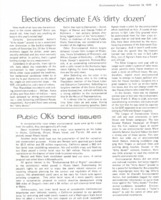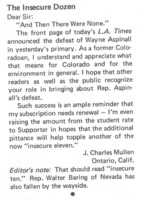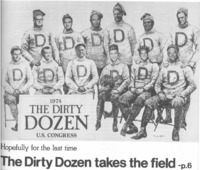The Dirty Dozen
Gaylord Nelson helped to start the environmental movement in part because environmentalists lacked the political capital to be taken seriously, but after Earth Day this changed. The new environmental lobbying organization was eager to prove that it had the muscle to affect political change in an electoral capacity. Environmental Action began to venture into the political sphere with the Dirty Dozen Campaigns. EA staff spent months scouring congressional voting records, searching for lawmakers with poor environmental records in preparation for the 1970 congressional elections.
The first campaign was for the November 1970 congressional elections. Environmental Action spent several months researching congressmen’s voting records before identifying 12 congressmen who were enemies of the environmental movement. Environmental Action leveraged their national credibility with the media and the public to identify and defeat lawmakers who were not responsive to the national climate on environmentalism. The first Dirty Dozen included E. Ross Adair, R-Indiana; William Ayres, R-Ohio; William Cowger, R-Kentucky; David Dennis, R-Indiana; George Fallon, D-Maryland; John Kyl, R-Iowa; Earl Landgrebe, R-Indiana; Odin Langen, R-Minnesota; Byron Rogers, D-Colorado; Henry Schadeberg, R-Wisconsin; Lawrence Winn, R-Kansas; and Roger Zion, R- Indiana.
These men were identified as enemies of the environmental movement and EA resources were devoted mobilizing local groups to influence and publicize the election. For example, E. Ross Adair from Indiana’s Fourth District in Fort Wayne was said to “consistently oppose issues which Environmental Action considers to be of the utmost domestic priority.” In his time in Congress, he “aided in the destruction of the environment” by supporting legislation that would build the SST, support the highway lobby, limit mass transit expenditures, eliminate funds for nature areas, oppose pesticide control and eliminate federal subsidies for sewage treatment. Seven out of twelve of the original Dirty Dozen lost their reelection campaigns.
Sources for this Page
Adam Rome, The Genius of Earth Day: How a 1970 Teach-In Unexpectedly Made the First Green Generation.
Environmental Action Newsletters.
Gaylord Nelson and Earth Day: The Making of the Modern Environmental Movement, Wisconsin Historical Society, http://www.nelsonearthday.net/collection/
Interview of Peter Harnik by Kiegan White, December 8, 2017, Ann Arbor, Michigan.




